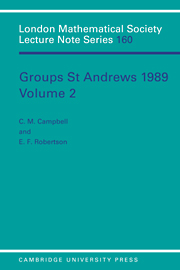Book contents
- Frontmatter
- Contents
- Preface
- Introduction
- 17 A survey of recent results on projective representations of the symmetric groups
- 18 Some applications of graded diagrams in combinatorial group theory
- 19 Rational growth of wreath products
- 20 The modular group and generalized Farey graphs
- 21 On the n-centre of a group
- 22 Existentially closed finitary linear groups
- 23 Permutability and subnormality of subgroups
- 24 Some applications of powerful p-groups
- 25 Combinatorial aspects of finitely generated virtually free groups
- 26 Problems in loop theory for group theorists
- 27 Sylow theory of CC-groups: a survey
- 28 On the minimal number of generators of certain groups
- 29 Lie properties of modular group algebras
- 30 Observations on a conjecture of Hans Zassenhaus
- 31 The Fibonacci groups revisited
- 32 Galois groups
- 33 Infinite simple permutation groups - a survey
- 34 Polynomial 2-cocyles
26 - Problems in loop theory for group theorists
Published online by Cambridge University Press: 13 March 2010
- Frontmatter
- Contents
- Preface
- Introduction
- 17 A survey of recent results on projective representations of the symmetric groups
- 18 Some applications of graded diagrams in combinatorial group theory
- 19 Rational growth of wreath products
- 20 The modular group and generalized Farey graphs
- 21 On the n-centre of a group
- 22 Existentially closed finitary linear groups
- 23 Permutability and subnormality of subgroups
- 24 Some applications of powerful p-groups
- 25 Combinatorial aspects of finitely generated virtually free groups
- 26 Problems in loop theory for group theorists
- 27 Sylow theory of CC-groups: a survey
- 28 On the minimal number of generators of certain groups
- 29 Lie properties of modular group algebras
- 30 Observations on a conjecture of Hans Zassenhaus
- 31 The Fibonacci groups revisited
- 32 Galois groups
- 33 Infinite simple permutation groups - a survey
- 34 Polynomial 2-cocyles
Summary
Introduction
The set of all left and right translations of a loop generates a group called the multiplication group of the loop. It is a well known fact that the concept of multiplication groups can very successfully be used in order to investigate loops. In this brief survey we shall proceed along two main lines: (1) the characterization of multiplication groups in purely group theoretic terms and (2) the structure and order of the multiplication group in the case that we have a finite centrally nilpotent loop. For the details of the results and their proofs we refer to [1] and [2].
Characterization of multiplication groups of loops
Let Q be a loop (thus Q is a groupoid with unique division and a neutral element). If a ∈ Q, then La(x) = ax and Ra(x) = xa define two permutations on Q called the left and the right translation. The set of all left and right translations generates a permutation group M(Q) and we say that M(Q) is the multiplication group of Q. Further, we denote by I(Q) the stabilizer of the neutral element This permutation group is called the inner mapping group of Q. It is not difficult to see that I(Q) = 1 if and only if Q is an abelian group. If Q is a group, then I(Q) consists of the inner automorphisms of Q. Now put A = {La: a ∈ Q} and B = {Ra: a ∈ Q}. Clearly, A and B are left (and right) transversals of I(Q) in M(Q).
Now we shall briefly introduce some notation.
- Type
- Chapter
- Information
- Groups St Andrews 1989 , pp. 396 - 399Publisher: Cambridge University PressPrint publication year: 1991



